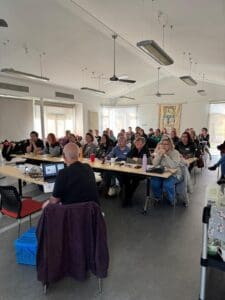Prepare to be captivated by Australia’s largest owl, the Powerful Owl (Ninox strenua), a magnificent nocturnal hunter that graces the forests and woodlands of the Macedon Ranges 6. With its deep, resonant “woo-hoo” call echoing through the night, the Powerful Owl is a true emblem of our region’s wild spaces 11.
The Powerful Owl is an imposing bird, typically measuring between 50 and 60 centimeters in length 11. Its plumage is a striking combination of dark grey to dark grey-brown on its back, adorned with distinctive white barring 11. Below, its chest and belly are an off-white hue, marked with characteristic dark v-shaped chevrons 11. Adding to its majestic appearance are its piercing yellow eyes, set within a dark grey-brown facial mask that aids in focusing sound 11. Its legs are feathered, leading to massive yellow to orange feet equipped with incredibly sharp talons – essential tools for a top predator 11. Interestingly, while the sexes look alike, the female Powerful Owl is generally smaller with a narrower head 11. Young Powerful Owls have a different appearance, covered in downy white feathers on their head and underparts, with sparse streaks below and much shorter tails compared to their adult counterparts 11. These physical attributes clearly demonstrate the owl’s adaptations for its role as a nocturnal predator, relying on excellent vision (implied by its hunting prowess) and powerful talons to secure its prey 11.
Within the Macedon Ranges, the Powerful Owl makes its home in the eucalypt forests and woodlands that characterize much of our landscape 6. These owls require large territories, with home ranges spanning an impressive 400 to 4000 hectares 6. This extensive need for space highlights the importance of maintaining large, connected forest habitats within the region for the species to thrive. Fragmentation of these forests could significantly hinder their ability to find sufficient food and suitable mates 6. Crucially, Powerful Owls rely on large hollows in mature trees for breeding 6. The availability of these nesting sites is a key factor in their survival, emphasizing the need to protect older trees within our forests.
As a top-order carnivore, the Powerful Owl plays a vital role in regulating populations of other animals within the ecosystem 6. Its diet primarily consists of medium to large tree-dwelling mammals, with a particular fondness for Common Ringtail Possums and Greater Gliders 6. This dietary preference makes the owl’s presence and successful raising of young a strong indicator of healthy populations of these prey species 6. However, the Powerful Owl’s menu is not limited to possums and gliders. It will also prey on roosting birds and occasionally small ground-dwelling mammals such as rabbits and small marsupials 11. There is even evidence that they may sometimes take bats, rodents, wallabies, and even young koalas 12. This reliance on a healthy prey base further solidifies the Powerful Owl’s role as an indicator species; its well-being is intrinsically linked to the abundance and diversity of other wildlife in the Macedon Ranges 6.
Powerful Owls are creatures of the night, exhibiting nocturnal habits 11. During the day, they often roost on branches in tall, open trees, sometimes even holding onto prey caught the previous night 13. Their flight is typically slow and deliberate on their large wings, allowing them to navigate the forest canopy with precision 13. These owls form strong pair bonds, mating for life, which can extend over 30 years in some cases 11. These pairs defend their all-purpose territory year-round 11. The male owl takes on the responsibility of preparing the nest, usually a vertical hollow in a large old tree, and provides a constant supply of food for the female and young during the early part of the nesting period 11. The female incubates the eggs and broods the young. Later in the nesting period, she will also emerge to hunt for food 11. Young Powerful Owls remain with their parents for several months after fledging and may even stay within their parents’ territory for over a year, highlighting a significant period of dependence 11. This extended parental care suggests a strong investment in each offspring, making the species vulnerable to factors affecting adult survival and breeding success.
Sadly, the Powerful Owl is listed as Vulnerable (VU) in Victoria 6. It is also listed under the State Flora and Fauna Guarantee Act 1988, recognizing its conservation significance 6. One of the primary threats to their survival is land clearing, which leads to the loss and fragmentation of their crucial forest habitat 11. While they can sometimes live in fragmented habitats such as farms or suburban areas, these environments often lack the large, old trees necessary for nesting and may present other dangers 11. Sadly, Powerful Owls are sometimes killed by cars, and young birds can fall prey to foxes, cats, or dogs 11.
Beyond their ecological importance, Powerful Owls hold a certain mystique. As Australia’s largest nocturnal bird, their presence adds to the wonder of our natural world 11. Their distinctive deep, double hoot, “woo-hoo,” is a characteristic sound of the Australian bush at night, a reminder of the wildness that still exists within our landscapes 11.
While the Macedon Ranges Wildlife Network may not have specific projects solely focused on Powerful Owls at this moment, our broader efforts in habitat protection and raising awareness about native wildlife directly benefit this magnificent species. By working to protect and connect forest habitats, we are ensuring the availability of both prey and nesting sites for the Powerful Owl.
You can contribute to the conservation of Powerful Owls in several ways. Protecting mature trees, especially those with hollows, is crucial for providing nesting habitat. Responsible pet ownership, including keeping cats indoors at night and dogs under control, can help reduce the risk of predation on young owls. Advocating for the preservation of our native forests and woodlands ensures the long-term survival of this species and the many others that depend on these ecosystems. If you are fortunate enough to spot a Powerful Owl, consider reporting your sighting to local citizen science initiatives or the Macedon Ranges Wildlife Network, as this data can help monitor their populations and inform conservation efforts. By working together, we can help ensure that the majestic call of the Powerful Owl continues to echo through the Macedon Ranges for generations to come.


